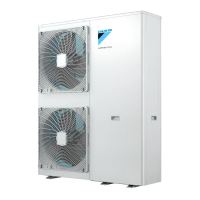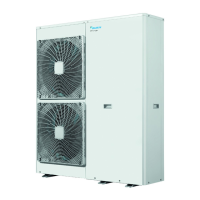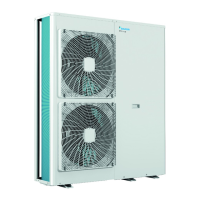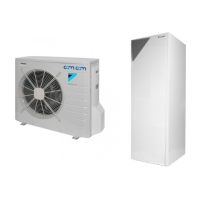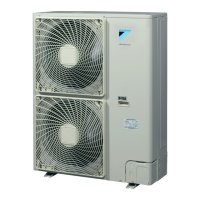8 Configuration
Installer reference guide
56
EBLQ+EDLQ011~016CAV3+W1 + EK(2)CB07CAV3 +
EKMBUHCA3V3+9W1
Daikin Altherma low temperature monobloc
4P522034-1 – 2018.01
# Code Description
[A.2.2.E.6] [C-06] Contact type add.
In external room thermostat control with
2 leaving water temperature zones, the
type of the optional room thermostat for
the additional leaving water temperature
zone must be set. See "5Application
guidelines"on page13.
▪ 1 (Thermo ON/OFF): See Contact
type main. Connected on the indoor
unit (X2M/1a).
▪ 2: N/A
If there are two zones (main+additional),
then only Thermo ON/OFF is possible.
Option box EK2CB07CAV3
Modification of these settings is only required when option box
EK2CB07CAV3 is installed. Option box EK2CB07CAV3 has multiple
functionalities which need to be configured. See "5 Application
guidelines"on page13.
# Code Description
[A.2.2.F.1] [C-02] Ext. backup heat src
Indicates if the space heating is also
performed by means of another heat
source than the system.
▪ 0 (No)(default): NOT installed.
▪ 1 (Bivalent): Installed. The auxiliary
boiler (gas boiler, oil burner) will
operate when the outdoor ambient
temperature is low. During bivalent
operation, the heat pump is turned
OFF. Set this value in case an
auxililary boiler is used. See
"5Application guidelines"on page13.
▪ 2: N/A
▪ 3: N/A
[A.2.2.F.2] [C-09] Alarm output
Indicates the logic of the alarm output on
option box EK2CB07CAV3 during a
malfunction.
▪ 0 (Normally open)(default): The alarm
output will be powered when an alarm
occurs. By setting this value, a
distinction is made between
malfunctioning and detection of a
power failure of the unit.
▪ 1 (Normally closed): The alarm output
will NOT be powered when an alarm
occurs. This installer setting allows for
a distinction between the detection of
an alarm, and the detection of a power
failure.
Also see the table below (Alarm output
logic).
[A.2.2.F.3] [D-08] Optional external kWh meter1:
▪ 0 (No): NOT installed
▪ 1: Installed (0.1pulse/kWh)
▪ 2: Installed (1pulse/kWh)
▪ 3: Installed (10pulse/kWh)
▪ 4: Installed (100pulse/kWh)
▪ 5: Installed (1000pulse/kWh)
# Code Description
[A.2.2.F.4] [D-09] Optional external kWh meter2:
▪ 0 (No): NOT installed
▪ 1: Installed (0.1pulse/kWh)
▪ 2: Installed (1pulse/kWh)
▪ 3: Installed (10pulse/kWh)
▪ 4: Installed (100pulse/kWh)
▪ 5: Installed (1000pulse/kWh)
# Code Description
[A.2.2.F.5] [C-08] External sensor (indoor):
When an optional external ambient
sensor is connected, the type of the
sensor must be set. See "5Application
guidelines"on page13.
▪ 0 (No): (default) NOT installed. The
thermistor in the user interface and in
the outdoor unit are used for
measurement.
▪ 1 (Outdoor sensor): Remote outdoor
sensor, connected to the outdoor unit.
The outdoor sensor will be used to
measure the outdoor ambient
temperature. Remark: For some
functionality, the temperature sensor
in the outdoor unit is still used.
▪ 2 (Room sensor): Remote indoor
sensor, connected to option box
EK2CB07CAV3. The temperature
sensor in the user interface is NOT
used anymore. Remark: This value
has only meaning in room thermostat
control.
INFORMATION
You can only connect either the remote indoor sensor or
the remote outdoor sensor.
# Code Description
[A.2.2.F.6] [D-04] PCC by digital inputs:
▪ 0 (No)
▪ 1 (Yes)
8.2.4 Quick wizard: Capacities (energy
metering)
The capacities of all electrical heaters must be set for the energy
metering and/or power consumption control feature to work properly.
When measuring the resistance value of each heater, you can set
the exact heater capacity and this will lead to more accurate energy
data.
# Code Description
[A.2.3.1] [6-02] Booster heater: Only applies to domestic
hot water tanks with an internal booster
heater (EKHW). The capacity of the
booster heater at nominal voltage.
Nominal value is 3kW. Default: 3kW.
Range: 0~10kW (in steps of 0.2kW)
[A.2.3.2] [6-03] BUH: step 1: The capacity of the first
step of the backup heater at nominal
voltage. Nominal value 3kW. Default:
3kW.
Range: 0~10kW (in steps of 0.2kW)
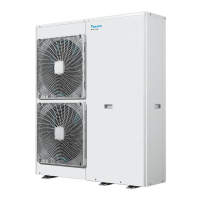
